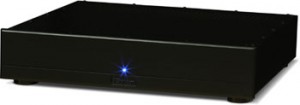I recently spent a lot of time with the new LFR1100 omnidirectional speakers, and something had me curious. If you're like me, you may have been thinking to yourself Sure, I know that the intials DSP stand for Digital Signal Processor, but what the heck is the audio DSP doing to those speakers anyway? I sat down with Andrew Welker today and posed the question to him, asking him to explain it in a way that even I could understand. Here's what he told me:

Axiom's Audio DSP
The DSP is an integral part of the LFR1100, and why we sell it as part of the set. It serves two main functions:
1. The first function is applicable to any speaker - to the LFR1100 or any of our products. When you use a traditional passive crossover network (not wall-powered but rather passive in that it uses capacitors, inductors and resistors), we are limited in how precise and how detailed we can get with those passive crossover networks. We can do a good job of getting the overall frequency response linear, both on-and off-axis, to get the Axiom Listening Window to look the way we want; however, the problem in a passive crossover is that you cant correct every area. The idea of the LFR1100 is to correct every little peak, dip, hump or null to create our most accurate speaker yet, with the added benefit of an expansive, yet accurate, soundstage.
So the main thing the DSP allows us to do is to take a speaker with a passive crossover and go the extra mile with the DSP to correct all those things which we can't make absolutely perfect, particularly when we go off-axis and we want the family of curves to look a certain way. Because we're dealing in the passive world we're dealing with part restrictions. There are not an infinite number of parts available, and to attempt to address this level of sound detail passively it would take well over 100 parts to get it right. By way of contrast, a normal passive crossover has 4-15 parts.
Using an audio DSP makes all of the curves look textbook-perfect on- and off-axis. It takes a good design and makes it that much better. (Aside - we'll be making it available for the M80 and the M60 in time).
We're applying that correction to both the front and back sections of the LFR.
2. Additionally, in the case of the LFR, the function of the DSP is also to make the rear drivers 'play nice' with the front drivers.

The LFR1100 speaker pictured front and back
Let’s assume that you have the front section of that LFR system measuring the way you want it to and sounding really nice. Now we add in the rear drivers. Even though on their own the rear sound is as accurate and flat as a good speaker on its own, (in fact, in the case of the LFR it would sound quite similar to the M22 bookshelf speakers note the configuration), when you add the front section of the speaker to them, you get some pretty bad interaction between the front and back sections.
Part of the reason is that they are separated by a distance - the depth of the cabinet in this case (17 inches) which creates a bit of a delay in the sound that comes from the back drivers compared to the sound coming from the front drivers. You'll not only hear it in your living room, but it is also clearly seen in the anechoic chamber.
This cancellation has been the major issue with the majority of bipolar-style speakers. At some frequencies, the sound from the back of the cabinet wraps around the side of the cabinet and combines with the sound from the front of the speakers. This cancellation phenomenon gives the speakers the really big sense of space that is the biggest feature of that family of speakers. However, those same interactions tend to distort the tonal balance, which can be especially heard in the midrange, making them not very focused and somewhat distant.
Where that cancellation typically takes place is also in the particular frequency range which helps us in our mind create the 'image' - a location of where the sound is coming from. In a typical bipolar with these cancellations, the image gets very washed out and indistinct.
Also, a point of clarification for those of you who have been asking: Bipole is defined as the front and rear sections are operating in phase with each other. A dipole, by contrast, means the front and rear sections are out-of-phase with one another, and that is not what we're doing with the LFR1100.
Unlike what we can do with a passive crossover, we have far more freedom with the corrections we can do digitally. In the case of the LFR, we want to adjust the frequency response of the back section so its no longer actually flat. If you were to look at graph of just the back drivers, it would look strange: but that’s because it is specifically designed to avoid those cancellations from taking place. Instead, what were trying to do is to tailor the frequency response of the speakers so you dont get those cancellations. We’re making the character of the front section sound the same, with or without the back drivers.
It’s a complex piece of engineering and coding hundreds of hours in all that you simply couldn’t perform with a passive crossover: the sheer volume of parts would start to negatively contribute to the sound of the speaker and waste a significant portion of your amplifier’s power.
I hope that helps you understand just what the LFR1100 audio DSP is doing as well as it helped me! Stay tuned (pun intended) for more posts on the inner workings of our latest speaker.



 Axiom's Audio DSP
Axiom's Audio DSP

